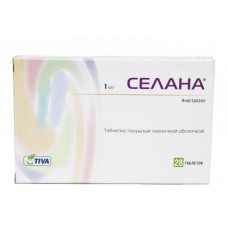Expiration date: 04/2026
Form release
Tablets, film-coated
Composition
1 tablet contains:
active substance: anastrozole 1 mg,
excipients: magnesium aluminometasilicate-9 mg, sodium croscarmellose-3 mg, silicon dioxide colloidal-3 mg, magnesium stearate-0, 5 mg, ludipress (in terms of components: lactose monohydrate-77, 7 mg, povidone-2, 9 mg, crospovidone-2, 9 mg) - 83, 5 mg
film shell: Opadry II white 85F48105 (polyvinyl alcohol-from 35 to 49%, talc - from 9, 8 to 25%, 3350 macrogol-from 7, 35 to 35, 2%, titanium dioxide-from 15, 15 to 30%) - 5 mg.
Pharmacological action
Pharmacodynamics.
Anastrozole is a highly selective nonsteroidal aromatase inhibitor. Aromatase-an enzyme by which women in the postmenopausal period Androstenedione in peripheral tissues is converted into estrone and further into estradiol. Anastrozole has antitumor activity against estrogen-dependent breast tumors in postmenopausal women. In the postmenopausal period, the drug in a daily dose of 1 mg causes a decrease in the concentration of estradiol by 80 %.
Anastrozole does not have progestogenic, androgenic and estrogenic activity.
Anastrozole in a daily dose of up to 10 mg has no effect on the secretion of cortisol and aldosterone (hence, the use of the drug does not require the replacement of corticosteroids).
Pharmacokinetics
Suction
After oral administration, anastrozole is rapidly absorbed from the gastrointestinal tract. The maximum plasma concentration (Cmax) is reached within 2 hours (fasting). Food slightly reduces the rate of absorption, but not its degree and does not lead to a clinically significant effect on the equilibrium concentration of the drug in plasma with a single daily dose.
Distribution
Anastrozole binds to plasma proteins by 40 %. After a 7-day dose of the drug is achieved for approximately 90 – 95% of the equilibrium concentration of anastrozole in plasma. There is no information about the dependence of pharmacokinetic parameters on time and dose.
Metabolism
Anastrozole is metabolized by N-dealkylation, hydroxylation, and glucuronidation. Triazole, the main metabolite determined in plasma, does not inhibit aromatase.
Breeding
Anastrozole is excreted slowly, the half-life (T1 / 2) is 40 – 50 hours.
Anastrozole and its metabolites are excreted primarily in the urine. Less than 10% of the dose is excreted in the urine unchanged for 72 hours after taking the drug.
Pharmacokinetics in special clinical cases.
The determined clearance of anastrozole after oral administration in patients with liver cirrhosis or renal dysfunction does not differ from the clearance determined in healthy people.
Pharmacokinetics of anastrozole does not depend on age in postmenopausal women.
Selana, indications for use
Adjuvant therapy of early hormone-positive breast cancer in postmenopausal women.
Treatment of advanced breast cancer in postmenopausal women.
Adjuvant therapy of early hormone-positive breast cancer in postmenopausal women after tamoxifen therapy for 2-3 years
Contraindications
Hypersensitivity to anastrozole and other components of the drug.
Severe renal failure (creatinine clearance less than 20 ml/min).
Severe liver failure (safety and efficacy not established).
Concomitant therapy with tamoxifen or medicines that contain estrogen.
Child age (safety and efficacy not established).
Premenopausal period.
Pregnancy and breastfeeding.
With caution.
Osteoporosis, hypercholesterolemia, lactase deficiency, lactose intolerance, glucose-galactose malabsorption (in the dosage form of the drug contains lactose), coronary heart disease, liver dysfunction.
Dosage and administration
Inside, swallowing it whole and washed down with water.
It is recommended to take the drug at the same time of day.
Adults, including elderly patients, the drug is prescribed 1 mg once a day, for a long time. If signs of disease progression appear, the drug should be stopped. As adjuvant therapy, the recommended duration of treatment is 5 years.
Patients with mild to moderate renal insufficiency do not require dose adjustment.
Patients with mild hepatic insufficiency do not require dose adjustment.
Side effect
From the endocrine system: "tides", vaginal dryness and thinning of hair.
From the digestive system: anorexia, nausea, vomiting, diarrhea. In patients with advanced breast cancer in most cases with liver metastases there was an increase in the level of GGT, less often-schf.
CNS: asthenia, drowsiness, headache.
Metabolism: slight rise in total cholesterol.
Allergic reactions: skin rash.
Special instruction
In case of uncertainty of the hormonal status of the patient, the state of menopause should be confirmed by additional biochemical studies.
The safety of anastrozole in patients with moderate hepatic impairment has not been established.
Anastrozole should not be used simultaneously with estrogen.
Impact on the ability to drive and operate machinery
During treatment should not perform work that requires high concentration and rapid psychomotor reactions.
Drug interaction
Anastrozole reduces the effectiveness of estrogen.
Clinical studies have shown that while the use of anastrozole with antipyrine and cimetidine drug interaction due to the induction of microsomal liver enzymes is unlikely.
Storage conditions
In a dry, dark place, at a temperature not exceeding 25 °C.
Shelf life 3 years.


